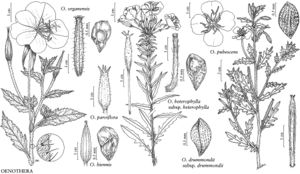Oenothera heterophylla subsp. heterophylla
Herbs densely to sparsely strigillose, also at least parts of inflorescence sparsely hirsute with spreading, pustulate-based hairs, and often glandular puberulent and villous. Flowers: buds with free tips spreading, 2–6 mm; floral-tube 25–42 mm; sepals 15–28 mm; petals 18–35 mm. 2n = 14.
Phenology: Flowering Jun–Sep.
Habitat: Sandy to sandy-loam soil of open sites in woodlands, with Persea borbonia, Pinus echinata, P. palustris, Quercus incana, Q. marilandica, Q. stellata, and Q. virginiana.
Elevation: 0–200 m.
Discussion
Populations of subsp. heterophylla were determined by W. Dietrich and W. L. Wagner (1988) to be self-incompatible. It occurs in a narrow range from eastern Texas (Austin, Bastrop, Brazos, Cass, Chambers, Cherokee, Dallas, Freestone, Gonzales, Gregg, Hardin, Harris, Henderson, Hopkins, Houston, Jasper, Lee, Leon, Liberty, Limestone, Nacogdoches, Newton, Robertson, Rusk, Sabine, San Augustine, San Jacinto, Smith, Sutton, Travis, Tyler, Upshur, Van Zandt, Victoria, Waller, and Wood counties) and southwestern Louisiana (Caddo, Calcasieu, Erwin, Natchitoches,and Winn parishes). It is known from several historical specimens in St. Louis, Missouri, as an adventive but is apparently no longer growing in that area.
Oenothera variifolia Steudel is a superfluous name that pertains here.
Selected References
None.
